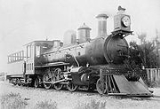
NZR V class
Encyclopedia
The NZR
V class steam locomotive was used on New Zealand
's railway network from 1885 onwards.
. Instead of the K class four coupled wheels, six coupled wheels were used. The order was placed with Nasmyth, Wilson and Company of Manchester
. It took seven years for delivery to be made and then it was found that the engines were 5 and a half tons overweight without their tender.
As a result the NZGR refused to accept the locomotives until the weight was pared down to an acceptable level. However by the time they were modified, the engines had been superseded by the American built NZR N class
of similar dimensions.
The Wellington and Manawatu Railway Company also ordered three of these locomotives, numbers 6, 7, and 8; at a cost of about £6000 (each). They were fitted with an ornate Rogers-styled wooden cab with Gothic windows, and an extended smokebox crowned with a copper-capped fulnnel. They could be fired with any light fuel including wood, and were very slightly heavier than the NZR version. They had inside frames and journals on both pony trucks. When the WMR was taken over by the NZR in 1908, they were included in the V class.
. WMR No. 7 was withdrawn and was replaced by the NZR K class (1932)
. No. 8 was withdrawn in 1937 and is now owned by Waitara Railway Preservation Society
.
New Zealand Railways Department
The New Zealand Railways Department, NZR or NZGR and often known as the "Railways", was a government department charged with owning and maintaining New Zealand's railway infrastructure and operating the railway system. The Department was created in 1880 and was reformed in 1981 into the New...
V class steam locomotive was used on New Zealand
New Zealand
New Zealand is an island country in the south-western Pacific Ocean comprising two main landmasses and numerous smaller islands. The country is situated some east of Australia across the Tasman Sea, and roughly south of the Pacific island nations of New Caledonia, Fiji, and Tonga...
's railway network from 1885 onwards.
Introduction
The heavy increase in traffic by the early 1880s necessitated a design for a new class of passenger locomotive. The V class was conceived as an enlarged version of the 2-4-2 NZR K class of 1877NZR K class (1877)
The NZR Rogers K class was the first example of American-built locomotives to be used on New Zealand's railways. Their success coloured locomotive development in New Zealand until the end of steam.-History:...
. Instead of the K class four coupled wheels, six coupled wheels were used. The order was placed with Nasmyth, Wilson and Company of Manchester
Manchester
Manchester is a city and metropolitan borough in Greater Manchester, England. According to the Office for National Statistics, the 2010 mid-year population estimate for Manchester was 498,800. Manchester lies within one of the UK's largest metropolitan areas, the metropolitan county of Greater...
. It took seven years for delivery to be made and then it was found that the engines were 5 and a half tons overweight without their tender.
As a result the NZGR refused to accept the locomotives until the weight was pared down to an acceptable level. However by the time they were modified, the engines had been superseded by the American built NZR N class
NZR N class
The N class were 12 steam locomotives that operated on the national rail network of New Zealand. They were built in three batches, including one batch of two engines for the private Wellington and Manawatu Railway Company, the WMR, by the Baldwin Locomotive Works in 1885, 1891, and 1901...
of similar dimensions.
The Wellington and Manawatu Railway Company also ordered three of these locomotives, numbers 6, 7, and 8; at a cost of about £6000 (each). They were fitted with an ornate Rogers-styled wooden cab with Gothic windows, and an extended smokebox crowned with a copper-capped fulnnel. They could be fired with any light fuel including wood, and were very slightly heavier than the NZR version. They had inside frames and journals on both pony trucks. When the WMR was taken over by the NZR in 1908, they were included in the V class.
Withdrawal
The first V class was withdrawn in 1925 and it was dumped into the a riverRiver
A river is a natural watercourse, usually freshwater, flowing towards an ocean, a lake, a sea, or another river. In a few cases, a river simply flows into the ground or dries up completely before reaching another body of water. Small rivers may also be called by several other names, including...
. WMR No. 7 was withdrawn and was replaced by the NZR K class (1932)
NZR K class (1932)
The NZR K class of 1932 was a class of mixed traffic 4-8-4 steam locomotives that operated on New Zealand's railway network. The locomotives were developed following the failure of the G class Garratts...
. No. 8 was withdrawn in 1937 and is now owned by Waitara Railway Preservation Society
Waitara Railway Preservation Society
The Waitara Railway Preservation Society is a society established in 1999 to operate a heritage railway over the former Waitara Branch Railway that operated between Lepperton and Waitara in the New Plymouth District of New Zealand's North Island...
.

